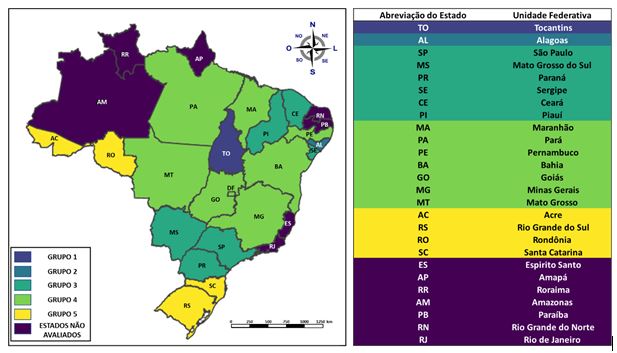Analysis of the peanut culture productive scenario and its relationship with production indices for brazilian regions and states
DOI:
https://doi.org/10.52755/sas.v2iedesp2.153Keywords:
Arachis hypogaea L., Oilseeds, Cluster analysis, Crop, descriptive statisticsAbstract
ABSTRACT
The peanut crop is part of the main oilseed crops in the world, providing various products from its grains, such as oil, proteins and vitamins. Objective: to organize Brazilian regions and states, according to production indicators, using descriptive statistical techniques and multivariate analysis of clusters. For the regional analysis, descriptive statistics were carried out in relation to the increase or reduction of the studied variables for the 2018/2019 and 2019/2020 harvests. The data were acquired from the base of the Brazilian Institute of Geography and Statistics (IBGE), in the Systematic Survey of Agricultural Production for planted area, harvested area and production, by crop year and crop product, where data for the 2018/2019 and 2019/2020 crop were selected and analyzed by means of the exploratory analysis of the multivariate grouping technique, using the hierarchical method. The groups were separated in relation to the decrease, constancy or increase in production indicators, resulting in the following groups: Group 1 = Tocantins (TO); Group 2 = Alagoas (AL); Group 3 = São Paulo (SP), Mato Grosso do Sul (MS), Paraná (PR), Sergipe (SE), Ceará, (CE), Piauí (PI); Group 4 = Pará (PA), Maranhão (MA), Pernambuco (PE), Bahia (BA), Minas Gerais (MG), Mato Grosso (MT), Goiás (GO); Group 5 = Rondônia (RO), Acre (AC), Santa Catarina (SC), Rio Grande do Sul (RS). The Southeast region had the largest area, production and productivity in the country, while the North and Northeast regions had the lowest rates as a whole. In Brazil, a large variation was observed in relation to production indicators and the multivariate study showed that it can be very important for producers, as it can collaborate in decision-making on investments and help in understanding the process of advancement or setback of the culture of the peanuts in Brazilian territory.
Downloads

Downloads
Published
How to Cite
Issue
Section
License
Copyright (c) 2021 Paulo Alexandre da Silva, Maria Elisa Vicentini , Bruna Cristina de Lima Candido , Alan Rodrigo Panosso, Glauco de Sousa Rolim

This work is licensed under a Creative Commons Attribution-NonCommercial-ShareAlike 4.0 International License.
Autores concordam com os seguintes termos:
a) Os autores mantêm os direitos autorais e concedem à revista o direito de primeira publicação, com o trabalho simultaneamente licenciado sob a LicençaAttribution-NonCommercial-ShareAlike 4.0 International, que permite o compartilhamento do trabalho com reconhecimento da autoria e publicação inicial na Revista SAS. A licença permite o uso, a distribuição e a reprodução irrestrita, em qualquer meio, desde que devidamente citada a fonte. Essa licença permite também que outros remixem, adaptem e criem a partir do seu trabalho para fins não comerciais, desde que atribuam a você o devido crédito e que licenciem as novas criações sob termos idênticos.
b) Não cabe aos autores compensação financeira a qualquer título, por artigos ou resenhas publicados na South American Sciences.
c) Os conceitos expressos nos artigos publicados na South American Sciences são de inteira responsabilidade de seus autores.








